About nkjkb
View all posts by nkjkb
Salmon in the NMR tube
Applying NMR spectroscopy and Magnetic Resonance Imaging, researchers at our department (Christian Totland, John Georg Seland and Willy Nerdal) and at Høgskulen på Vestlandet (Signe Steinkopf) document how reduction in marine omega-3 in farmed salmon affects salmon fillet features, right down at the molecular level. The study shows that carbon magnetic resonance spectroscopy direct on the fish meat can quantify the most relevant fatty acids within 40 minutes without the use of chemicals such as chloroform. In 1990, omega-3 in farmed salmon was predominantly marine fatty acids while there are now roughly equal levels of omega-3 from plants and marine sources. 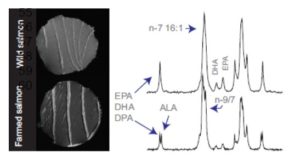 MR images show differences in texture between wild and farmed salmon, where wild salmon have narrower lines of fat tissue compared to farmed salmon. In addition, the muscle tissue of farmed salmon shows buildup of fat, known as marbled fat. The softer consistency of farmed salmon can be viewed in conjunction with fat profile.
MR images show differences in texture between wild and farmed salmon, where wild salmon have narrower lines of fat tissue compared to farmed salmon. In addition, the muscle tissue of farmed salmon shows buildup of fat, known as marbled fat. The softer consistency of farmed salmon can be viewed in conjunction with fat profile.
3D printing til nytte og glede!
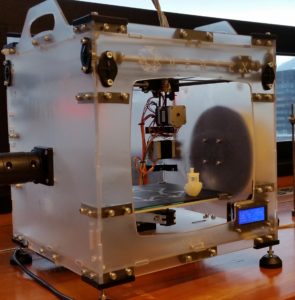 På tampen av 2016 ble det kjøpt inn en 3D-skriver (Velleman Vertex K8400) til petroleum- og kolloidkjemi-laben i 4. etasje. Skriveren kan gi oss reservedeler til gamle instrumenter hvor deletilgangen er dårlig. Den er også egnet til å lage annet labutstyr tilpasset våre behov. Skriveren er nå montert og noen testutskrifter har blitt kjørt med stor suksess.
På tampen av 2016 ble det kjøpt inn en 3D-skriver (Velleman Vertex K8400) til petroleum- og kolloidkjemi-laben i 4. etasje. Skriveren kan gi oss reservedeler til gamle instrumenter hvor deletilgangen er dårlig. Den er også egnet til å lage annet labutstyr tilpasset våre behov. Skriveren er nå montert og noen testutskrifter har blitt kjørt med stor suksess.
Til høyre er et sentrifugehode som påmontert vår Black&Decker-maskin gir en relativ sentrifugalkraft på nesten 50000 (rcf = 49700 × g), adskillig mer enn hva vår benksentrifuge kan klare (~20000 × g).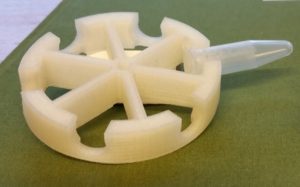
Om skriveren
Skriveren kan skrive ut gjenstander på ca. 20cm × 20cm × 20cm. Skriveren har ett skrivehode, som legger ut en streng av smeltet polymer, lag på lag, minste lagtykkelse er ca 50µm.
3D-Modeller
For å skrive ut en gjenstand må vi ha en 3d-modell. Denne kan lages selv i programmer som Sketchup og tilsvarende. Det finnes også mange modeller på nettet som man kan hente ned gratis, for eksempel fra Thingiverse. Programmer som fulgte med skriveren gjør modellen om til en skriverkode som skriveren forstår. Koden kan legges inn på et SD-kort, skriveren må ikke være tilkoblet PC for å skrive ut.
Lyst til å prøve?
Ta kontakt med Tore Skodvin!
Congrats, Dr. Camilla!
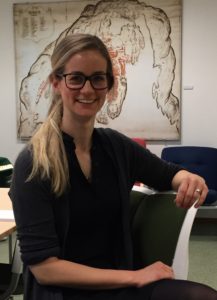 Last Friday, Camilla Løhre successfully defended her thesis, titled «The effect of input material pretreatment on product yield
Last Friday, Camilla Løhre successfully defended her thesis, titled «The effect of input material pretreatment on product yield 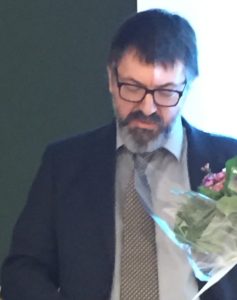
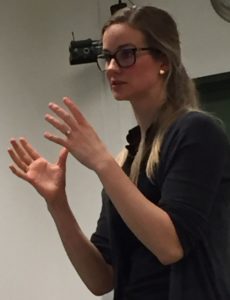 and composition of bio-oils from LtL solvolysis. A continuous process for organosolv fractionation of lignocellulosic biomass and solvolytic conversion of lignin.» Camilla seized the opportunity (not the opponent) with both hands and came out victorious.
and composition of bio-oils from LtL solvolysis. A continuous process for organosolv fractionation of lignocellulosic biomass and solvolytic conversion of lignin.» Camilla seized the opportunity (not the opponent) with both hands and came out victorious.
New instrumentation for Flow chemistry
January 16-17 will be days to remember for the Department of Chemistry. Modern instrumentation for flow synthesis was installed and a bunch of enthusiastic users from the section of Organic Synthesis and Medicinal Chemistry received training on the new system.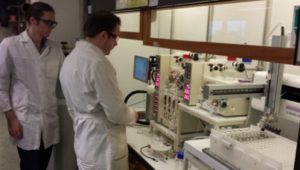
This installation represents a leap from equipment invented in the era of the alchemy (the glass flask) into modern computerized flow-chemistry instrumentation. It is a highly modular and versatile system composed by several feeding pumps, reactor manifolds and thus also various types of reactors. The control and monitoring program also allows combining in-house developed and third party equipment. The instrumentation is designed, produced and delivered by Vapourtec.
Jubileumsseminar i Aulaen fredag kl 13-16 – Geofysen er 100 år
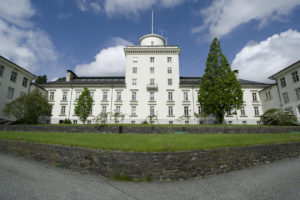 I 2017 er Geofysisk institutt 100 år. Jubileet blir feiret gjennom hele året på ulike måter og gjennom forskjellige arrangementer. Det første arrangementet – Jubileumsseminaret i Universitetets Aula er i morgen, fredag 6. januar og er åpent for alle. Seminaret er i to deler, og spesielt sesjon 2, om fornybar energi, vil være av stor interesse for mange på Kjemisk institutt.
I 2017 er Geofysisk institutt 100 år. Jubileet blir feiret gjennom hele året på ulike måter og gjennom forskjellige arrangementer. Det første arrangementet – Jubileumsseminaret i Universitetets Aula er i morgen, fredag 6. januar og er åpent for alle. Seminaret er i to deler, og spesielt sesjon 2, om fornybar energi, vil være av stor interesse for mange på Kjemisk institutt.
kl. 13.00-14: Geofysen – En lokal aktør på nasjonale og internasjonale arenaer
kl 14.15-16: Energi fra sol vind og vann – en lokal og global utfordring
Se flere detaljer her.
Korleis kombinere tradisjonell undervisning med nettundervisning?
I fleire av emna våre kan det vere nyttig å erstatte og/eller komplementere deler av den vanlege undervisninga med studentaktivitet over nettet. Dette kan brukast både til mengdetrening og stoffgjennomgang for utvalde deler av pensum. Program for universitetspedagogikk inviterer denne våren til eit kurs i nettopp How to Design and Teach Blended Courses. Kurset UPED63X går over 3 dagar (23. februar, 23. mars og 20. april) og du kan finn lenke for å registrere deg her. For meir detaljert informasjon, sjå tekst.
PatentPak is now available

PatentPak is now available as an option in SciFinder. It is a rapid way of getting directly to the chemical information at the location in the patent. For more information, you can take a look at this site , or consult a youtube video such as this one.
Welcome to Raju!
Dr. Raju Dey recently joined the chemistry department as a postdoctoral researcher to work on the design of homogeneous late transition-metal catalysts for hydrodeoxygenation of lignin model compounds. 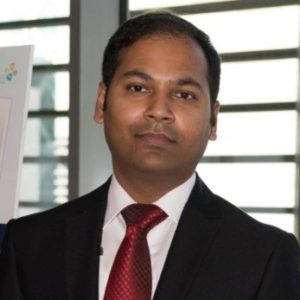 His project is a part of the ENERGI-X project “Renewable aromatics for fuel blending from lignin by novel homogeneous catalysis.” Raju Dey is from Kolkata, India, where he completed his MSc and PhD degrees in Chemistry with emphasis on organic chemistry, organometallic chemistry and heterogeneous catalysis.
His project is a part of the ENERGI-X project “Renewable aromatics for fuel blending from lignin by novel homogeneous catalysis.” Raju Dey is from Kolkata, India, where he completed his MSc and PhD degrees in Chemistry with emphasis on organic chemistry, organometallic chemistry and heterogeneous catalysis.
Dr Mikel joins the club
 Mikel Oregi Bengoetxea stood tall and defended his thesis Formic acid aided catalytic lignin conversion in ethanol and water media today. You may read more about his work (in Norwegian) here.
Mikel Oregi Bengoetxea stood tall and defended his thesis Formic acid aided catalytic lignin conversion in ethanol and water media today. You may read more about his work (in Norwegian) here.
Mikel’s portrait has already joined the yet-to-be-inaugurated Gallery of PhD graduates from the Department of Chemistry (2016 onward). The gallery may be found across from the reciprocal room!
State of the Pub Gallery
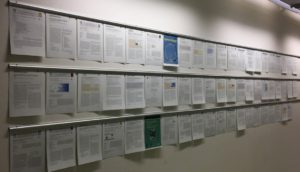 As of December 20, the paper wall (aka as the pub gallery) counts 60 peer-reviewed papers published in scientific journals in 2016, featuring at least one coauthor affiliated with the Department of Chemistry. Nice!
As of December 20, the paper wall (aka as the pub gallery) counts 60 peer-reviewed papers published in scientific journals in 2016, featuring at least one coauthor affiliated with the Department of Chemistry. Nice!